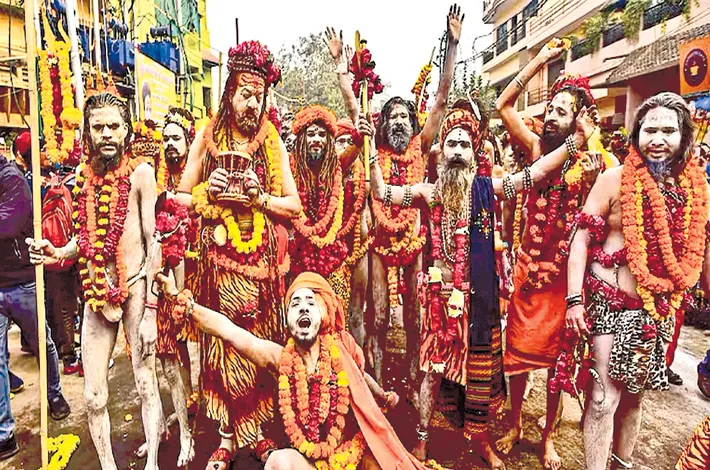The Enigmatic Naga Sadhus: Guardians of the Kumbh
16-01-2025 12:00:00 AM

In the vast, sprawling landscape of India, where the Ganges River meets the Yamuna and the mythical Saraswati at Prayagraj, an event unfolds every twelve years that seems to defy the very laws of nature and time. This is the Maha Kumbh Mela, the largest religious gathering on Earth, where millions converge to witness the mystical and the unknown. Among the sea of devotees, one group stands out for their enigmatic presence and mysterious ways – the Naga Sadhus.
These ascetics, clad in nothing but sacred ash, their bodies adorned with rudraksha beads and their hair often matted and dreadlocked, appear as if from another era, perhaps even another realm. Their presence at the Maha Kumbh Mela is not just a participation; it's a profound statement on the transience of human life and the eternal quest for Moksha, liberation from the cycle of birth and death.
The Naga Sadhus' journey to the Mela is a spectacle in itself. They travel in groups, known as Akharas, each with its own traditions and rituals. Their processions are led by their leaders, or Mahamandaleshwars, riding elephants with banners waving high, drums beating, and chants filling the air. The air is charged with an anticipatory energy as they approach the Mela grounds.
Their arrival is as silent as a shadow creeping at dawn. No one knows exactly when they will appear, but the signs are there. They come from the dense forests, the Himalayan caves, or even the remote ashrams where they lead lives of solitude. Their presence is both captivating and intimidating, as if they hold the very fabric of reality within their grasp.
As the Maha Kumbh Mela gains momentum, the Naga Sadhus take center stage, leading processions, performing rituals, and imparting wisdom to the gathered masses. They are the first to take the holy dip in the sacred rivers during the Shahi Snan, or royal bath, which is a highlight of the Kumbh Mela. Theirs is a world where the boundaries of reality are stretched, and the impossible becomes possible.
But their disappearance is even more mysterious. After the Shahi Snan or after their spiritual objectives are met, they vanish back into the obscurity from whence they came. It happens gradually, almost imperceptibly. One day, you might see a large group of them, their tents and fires dotting the landscape; the next, you find their camps empty, only the remnants of ash and sacred fires left behind.
They slip away in the night or at dawn, with only the most observant noticing their departure. The mechanics of their coming and going are steeped in mystique. Some say it's their deep connection with the elements, with nature itself, that allows them to blend into the forest or disappear into the crowd with such ease.
Their lives are so intertwined with the spiritual that they seem to possess an almost supernatural ability to move unnoticed, to be here one moment and gone the next. Stories abound about how they manage this. Some tales speak of secret tunnels beneath the land, known only to them, through which they come and go.
Others suggest that their mastery over yogic practices like invisibility, or the ability to control breath and body to such an extent that they can merge with their surroundings, explains their mysterious appearances and disappearances. At the Maha Kumbh Mela, amidst the cacophony of millions, their silence speaks volumes.
They are not just visitors; they are the living embodiment of ancient traditions, keepers of esoteric knowledge, and custodians of a spiritual legacy that predates the modern world. They come to remind the world of the impermanence of life, the pursuit of higher consciousness, and the beauty of renunciation.
And then, just as they appeared, they are gone. The Mela continues, the crowd thins, and life returns to normal, but the mystique of the Naga Sadhus lingers like the smoke from their sacred fires, a reminder of a world beyond the tangible, where the divine and human dance in the shadows of time.








